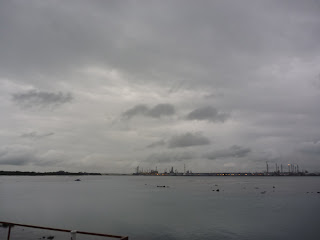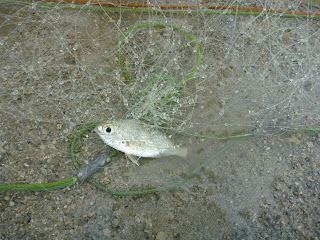A group of students from Nan Hua high school joined me on a morning of adventure at Pulau Semakau. They were the Green Reps/ Ambassadors of their school, and I hope they will take home the message of conservation, and the 3Rs (Reuse, Reduce, Recycle) for sharing with their friends.
Once again, we were all intrigued by the rich marine life on our shores - something that many of us do not expect.
Apart from this Dragonfish Sea Cucumber (Stichopus horrens) that the hunter-seekers found, our group also saw 2 others as we waddled through the 'deathzone' of the seagrass lagoon. This species of Sea Cucumber is said to melt and disintegrate when exposed in the sun for too long. It can also shed its skin when stressed, so be sure not to disturb it unnecessarily.
Often thought to be a worm by first-time visitors to our shores, the Synaptid Sea Cucumber (Family Synaptidae) was a great show-and-tell partner. As I was introducing it to the crowd, it gamely showed us how it lashes its beautiful tentacles to feed on detritus in the water.
The participants treaded carefully for fear of stepping on a 'land mine' - the Sandsifting Sea Stars (Archaster typicus) were half buried in the sand. Camouflaging fairly well into the surroundings, we might just step on one if we don't watch our step. While they do not have a brain, and might not feel any pain, we can never be sure, can we?
I must apologise for the photo that doesnt do the Knobbly Sea Star (
Protoreaster nodosus) any justice. Apart from being the icon for
Project Semakau, our Knobblies often awed our visitors with its vibrant colours, pretty knobs (that gave its common name) and its sheer size (it can grow up to 30cm wide!). This Sea Star has a calcified body which makes it difficult for predators to prey on it.
Although mildly venomous, be sure not to touch the Black Long-spined Sea Urchin (Diadema setosum) as the spines can give painful stings if stepped on. The brittle and needle-like spines makes it challenging to extract it from our flesh too. In addition to being a defense mechanism, the spines , in partnership with the Sea Urchin's tube feet, helps it to walk.
My first time seeing a Juvenile Noble Volute (Cymbiola nobilis) whose shell is of a much darker shade. We were really lucky to see a pretty adult too. Unfortunately, this snail's existance is threatened due to habitat loss and over-collection of its beautiful shell - I have seen ,on several occasions, bazaar stalls selling spoons made from the volute's shell!
The Spider Conch (Lambis Lambis) may look unattractive at first glance, but I never fail to hear the visitors' 'Wahhhhh' when I turn it over to show its underside. Named after the spikes on the shell's edge that resembles the legs of a spider, the Spider Conch has a strong operculum and foot that allows it to pole-vault away on the surface.
Our adorable Polka-dot Nudibranch (Jorunna funebris) made a guest appearance too. Named after its exposed naked gills (the feather like structures), Nudibranchs are sea slugs and actually have shells when they are young, but sheds their shell thereafter. They thus develop other defense mechanism such as having warning predators that they are distasteful or poisonous with their bright colours.
Its my first encounter with this Nudibranch (and I believe its a first record for Semakau!). Not quite sure what species this is, but it certainly is huge, almost as long as the length of my 26cm chopstick!
Nearby, we also saw these egg ribbons, not sure if it was the eggs of the Nudibranch, but certainly a good sign that our shores are thriving with life!
It was Bull's eye for the group on their guess of how the Flatworm got its name - 'cause they are really flat! Pseudoceros sp. was the only species we saw that day and the participants were surprised to hear that the flatworm is a Hermaphrodite which possesses both the male and female reproduction organs. Unlike us, flatworms have no circulatory and respiratory organs,instead oxygen and nutrients pass through their bodies by diffusion.
I had to remind the participants to be extra careful as we wade through the water near the reefs after noticing a few Sea Nettle Jellyfishes (Chrysaora sp.) pulsating near us - contact with their tentacles can result in quite painful stings! Jellyfishes also do not have specialized respiratory, or circulatory systems as their skin is thin enough for the body to be oxygenated by diffusion.
Another Jellyfish we saw was this Upside-down Jellyfish (Cassiopea sp.) which gives a milder sting that can cause skin irritation with an exceptional itch. No prizes though, for correct guesses on how it got its common name. This Jellyfish harbours a mutually beneficial relationship with zooanthellae (single-celled photosynthetic algae) that is housed in its body. The algae shares its food with the jellyfish who in turns provides a home and minerals for the algae.
Occasionally mistaken for the Upside-down Jellyfish, the Hell's Fire Anemone (Actinodendron sp.) is one you don't want to mess with. Aptly described by one volunteer, the sting from this Anemone burns you like how a fire will, and hurts like 'hell'. Although I have no personal experience to speak of, I sure don't want a taste of that feeling. One can identify the Anemone by its radiating white stripes from its centre disk, and its branching triangular-shaped tentacles.
We were really lucky to see this Heart Cockle (Corculum cardissa), not as commonly seen due to overcollection of its shell. A simple googling will show you how its being marketed as a token of love, sold a fairly cheap price. Little do couples noticed that this clam's opening of the valves cuts vertically across the centre of the 'heart', just like how we often depict a broken heart. In my opinion, a bad omen and not a good token of love at all!
Per usual trips, we had a chance to visit our resident Fluted Giant Claim (Tridacna squamosa), but for as long as we keep the environment protected, clean and for its growth. Unlike most other bivalves, the giant clam harbours single-celled algae ,in its fleshy body, which produces food through photosynthesis. To maximise its "farm", the clam exposes these algae to the sunlight by facing the mantle to sunlight, at the same time, giving us a wide smile!
Yet another fruitful trip to round up my intertidal walks in March. =)























































